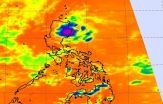(Press-News.org) MADISON, Wis. -- If you have two working eyes, you are live streaming two images of the world into your brain. Your brain combines the two to produce a view of the world that appears as though you had a single eye -- like the Cyclops from Greek mythology.
And that's a good thing, as the combination of the two images makes for a much more useful impression of the world. With one eye shut, catching a ball or parking a car become far more difficult.
"If you're reaching out with your hand, you want to aim not at where things appear to be, but where they are," says Bas Rokers, psychology professor at the University of Wisconsin-Madison. "Two eyes are giving you two images that don't by themselves tell you where things are relative to your hand. It's the integrated information that tells you where things are."
Using prisms and an advanced brain scanner, Rokers and collaborators at Utrecht University in the Netherlands have found the point in the human brain -- very early in image processing in the visual cortex -- in which the transformation to a cyclopean view of the world takes place.
Their work, published recently in the journal Current Biology, may aid in the treatment of vision problems like amblyopia, or lazy eye.
"We're not necessarily interested in what activity stimuli produce on our sensory organs while we're using them," Rokers says. "We're interested in what they tell us about where things are in the world. This transformation to cyclopean vision is central to figuring that out."
According to Rokers, a group of neurons in the visual cortex called the striate cortex, or V1, is handling two sets of pictures from our eyes -- one view each from the left eye and the right eye. Move one step down the line to an area called V2, part of the extrastriate cortex, and the neurons have largely shifted to a single picture. The research clears up unsettled questions as to what purpose V2 serves in visual processing.
The researchers tucked people in functional MRI machines, and had them peer into a prismatic device that showed each eye a different image. For example, the left eye would see a vertical black bar slightly to the right of center, while the right eye saw the bar slightly to the left of center.
"The brain processes the two presented images like it would with any normal pair of images, and perceives them as a single bar in the center of the field of vision, but shifted slightly backwards in depth," Rokers says.
Because the MRI results are sharp enough to discern the different brain activity signatures for each vertical bar, the researchers could compare brain activity when the bars were presented to each eye separately or both eyes together.
"What we show is that in V1, that activity goes with the presented location -- some neurons see the left eye image, some the right eye image," Rokers says. "But in V2, the activity matches the perceived, centered location. V2 is working with the combined, cyclopean image."
The researchers plan to shift their attention to finer layers of V1, as well as to an area called V3, with an eye toward figuring out where the brain brings depth and object shape into focus. Rokers expects that a better understanding of the way images are processed will help with ongoing research into disorders like lazy eye. In amblyopia, the most common cause of vision problems among children around the world, the brain learns to favor the images of a stronger eye over those from one that is weaker or misaligned.
"Now that we know where to look in amblyopia, we can focus on these brain regions and see if the representation has shifted toward the dominant eye," Rokers says. "And we could get a sense of how successful we've been in treating amblyopia if we see activity in V2 shift back toward a cyclopean representation."
INFORMATION:
CONTACT: Bas Rokers, 608-262-8992, rokers@wisc.edu
Chris Barncard, 608-890-0465, barncard@wisc.edu
Everybody grieves the death of a loved one, and the process helps most mourners adjust to their loss.
"Charlie Brown was right," said Christopher Layne, a psychologist and researcher at the Semel Institute for Neuroscience and Human Behavior at UCLA. "There is good grief."
But for some people, bereavement becomes a problem in itself, prolonging suffering and impairing functioning. For grieving children and adolescents persistent complex bereavement disorder can derail social and academic development at a time when children and adolescents need to master skills and form ...
PULLMAN, Wash.--Washington State University scientists have found that glyphosate, the main ingredient in the herbicide Roundup, does not accumulate in mother's breast milk.
Michelle McGuire, an associate professor in the WSU School of Biological Sciences, is the lead researcher of the study, the first to have its results independently verified by an accredited, outside organization.
Her findings, presented at the Federation of American Societies for Experimental Biology Conference on July 23 in Big Sky, Mont., show that glyphosate, the most used weed-killing chemical ...
Sometimes consumers might appreciate a pop-up ad that reflects the merchandise they were recently browsing online, and sometimes they just might decide to spike it and thereafter avoid the seller that placed the ad. Retailers can learn about this behavior in the September 2015 issue of the Journal of Retailing.
In "The Importance of Trust for Personalized Online Advertising," Marketing Professors Alexander Bleier, of Boston College's Carroll School of Management, and Maik Eisenbeiss, of the University of Bremen, show how trust in a particular vendor affects the degree ...
When Tropical Depression 12W formed on the northeastern tip of the Philippines in the Luzon Region, NASA's Aqua satellite captured infrared data on the newborn storm.
The Atmospheric Infrared Sounder (AIRS) instrument that flies aboard NASA's Aqua satellite captured infrared data on Tropical Depression 12W. AIRS data showed some cloud top temperatures were as cold as -63F/-53C on July 23 at 5:17 UTC (1:17 a.m. EDT). Cloud top temperatures that cold have been shown to generate heavy rainfall.
Tropical Depression 12W (TD12W) formed at 0900 UTC (5 a.m. EDT) on July 23 ...
Fairfax, Va., July 22, 2015 - The American Society for Radiation Oncology (ASTRO) is concerned about proposed additional payment cuts to radiation therapy detailed in the Centers for Medicare and Medicaid Services' (CMS) proposed Medicare Physician Fee Schedule (MPFS), released July 8, 2015, which will take effect on January 1, 2016. Freestanding centers estimate that the combined impact of the Medicare proposals would result in a five to seven percent reduction in payment for radiation oncology services at community-based centers, although the cuts will vary and could ...
Tropical Storm Felicia was born early on July 23 in the Eastern Pacific Ocean, over 400 miles southwest of Baja California's southern tip. NOAA's GOES-West satellite provided an infrared image of the newborn storm.
Previously known as tropical low pressure area "System 99E," the storm finally developed after days of remaining unorganized. NOAA's GOES-West satellite captured an image of Tropical Storm Felicia on July 23, 2015 at 15:45 UTC (11:45 a.m. EDT). Satellite imagery shows that a curved band of thunderstorms are wrapping around the southern quadrant of the storm.
The ...
Researchers in the Division of Hematology, Oncology and Blood & Marrow Transplantation at Children's Hospital Los Angeles have shown greatly improved outcomes in using stem cell transplantation to treat patients with a serious but very rare form of chronic blood cancer called juvenile myelomonocytic leukemia (JMML).
Allogeneic hematopoietic stem cell transplantation (HSCT) involves the transplantation of stem cells from a donor, which may be derived from bone marrow, peripheral blood or umbilical cord blood. The recipient's immune system is usually destroyed with radiation ...
Researchers from Scripps Institution of Oceanography at UC San Diego have accurately mapped out the movement of the devastating 7.8-magnitude Nepal earthquake that killed over 9,000 and injured over 23,000 people. Scientists have determined that the earthquake was a rupture consisting of three different stages. The study could help a rapidly growing region understand its future seismic risks.
The Himalayan region is particularly prone to earthquakes and this study will serve as an important benchmark for understanding where future earthquakes may occur, especially ...
SEDE BOQER, Israel...July 23, 2015 - Ben-Gurion University of the Negev (BGU) and University of Western Australia researchers have developed a new process to develop few-layer graphene for use in energy storage and other material applications that is faster, potentially scalable and surmounts some of the current graphene production limitations.
Graphene is a thin atomic layer of graphite (used in pencils) with numerous properties that could be valuable in a variety of applications, including medicine, electronics and energy. Discovered only 11 years ago, graphene is one ...
The physical symptoms of weakness and fatigue from multiple sclerosis (MS) can rock a person's confidence and ability to engage in what he or she feels is important, from being a good parent and friend to taking up a hobby, according to Matthew Plow, assistant professor from Case Western Reserve University's Frances Payne Bolton School of Nursing.
To help people with MS maintain autonomy and independence, a team of researchers set out to determine what factors prevented individuals from undertaking and enjoying the activities they believe are most important to live fulfilling ...

